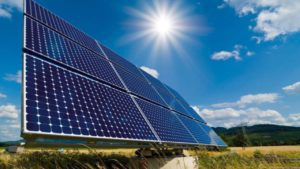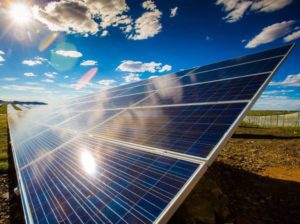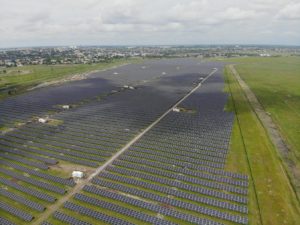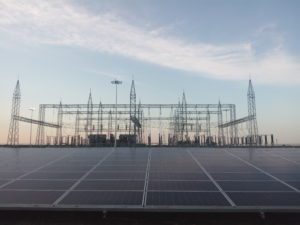
UDP Renewables has launched the Port Solar solar power plant with a capacity of 8.6 MW in Izmail, Odesa region.
According to the press service of the company, more than 25,700 solar panels manufactured by Jinko Solar (the largest global manufacturer of solar panels) are installed on an area of 16 hectares. It is expected that the plant will generate about 11,800 MWh of electricity annually.
The co-investor in the facility is Slovakia’s E-Group, the general contractor is the Metropolia Group of Companies (Kyiv).
“Involving the experience of our partners, UFuture and UDP Renewables are working to ensure that energy production in Ukraine complies with the best global environmental safety and energy efficiency practices. Our goal is more than 300 MW by 2022. Now we are following the plan, gradually implementing projects in the regions with the highest solar activity – Odesa, Zaporizhia, Kherson and Mykolaiv regions,” the press service said, citing the founder of the UFuture investment group Vasyl Khmelnytsky.
The company also reported that Ukrainian-built equipment worth over UAH 44.5 million was used in the construction of this plant. The total amount of attracted investments amounted to EUR 6.75 million.
UDP Renewables is an investment and development company in the field of renewable energy. It is part of the UFuture investment group, which belongs to Khmelnytsky.
E-Group is part of the INDUSTRY investments sub-fund that invests in energy. It belongs to the portfolio of the qualified investors fund ZMJ SICAV.

Norway’s Norsk Solar has signed an agreement with the Voltage Group Ukrainian Company for designing and building of a 9 MW solar power plant near the town of Brovary in Kyiv region, the Nordic Environment Finance Corporation (NEFCO) reported on its website. According to the NEFCO, Voltage Group developed design documentation for construction of the solar plant on a total land area of 12.6 hectares.
The plant, which is located in the village of Semypolky, is to be commissioned at the end of 2019.
As reported, the NEFCO will lend EUR 4.35 million to Norway’s Norsk Solar for the construction of the plant, while Norsk Solar will issue another EUR 4.35 million.
The project owner and majority equity contributor, Norsk Solar AS, is part of the Norsk Vind group.
Norsk Solar is owned by Norwegian Lars Helge Helvig.
Ukrainian SPP will be the second such kind of a project for the company.
BUILDING, CONTRACT, KYIV, NORSK SOLAR, SOLAR POWER PLANT, UKRAINIAN CONTRACTOR

UDP Renewables, a part of UFuture Investment Group, has launched its new solar power plant Scythia-Solar-2 in Melitopol (Zaporizhia region).
“UFuture and UDP Renewables continue to consistently realize the economic potential of Ukraine’s southern region following our long-term energy strategy. Now, the share of renewable energy sources in our country’s energy mix is only about 3%, but together we work towards changing this ratio. Our target is more than 160 MW of total production capacity by the end of 2019,” Founder of UFuture, Vasyl Khmelnytsky, said.
Scythia-Solar-2, with a peak capacity of 33.1 MW, occupies land area of 50 ha and consists of more than 91,000 solar modules produced by JA Solar. New PV PP will generate almost 42,000 MWh per year enabling to power 13,300 households.
“Scythia-Solar-2 is a high-tech facility. It is the second phase of our largest project Scythia-Solar, which we have started implementing in 2018. We have traditionally cooperated with Ukrainian equipment manufacturers and providers of respective services worth of UAH 288.5 million. During different stages of PV PP’s construction and operation, we created 315 jobs,” Managing Partner of UDP Renewables, Sergiy Yevtushenko, emphasized.
The project attracted €21.58 million of investments. The total capacity of two phases of Scythia-Solar is 46 MW, and the total investment reached €31.68 million. The launch of Scythia-Solar-2, instead of coal-fired power plants, will prevent 51 thousand tons of carbon dioxide emissions per year. Its general contractor is a Ukrainian group of companies, KNESS, and the financial partner is Oschadbank.
UDP Renewables is an investment and development company in the Ukrainian renewable energy sector. With diversification in type of renewable power generation and geography, by 2022 UDP Renewables strives to become one of the largest producers of clean energy in Ukraine, with total capacity of more than 300 MW. UDP Renewables is a part of UFuture Investment Group, a Ukrainian private equity firm and group of companies based in Kyiv. It unites businesses and social projects of Ukrainian entrepreneur Vasyl Khmelnytsky. Throughout its 20-year history, the group has accumulated a diversified portfolio of assets that spans both traditional sectors and industries of the future, and ranges from real estate, infrastructure and manufacturing to pharmaceuticals, renewable energy and technology.
INVEST, MELITOPOL, SOLAR POWER PLANT, UDP, VASYL KHMELNYTSKY

JSC Mykolaivoblenergo has concluded an agreement with Mykolaiv-based Svitlolux-Elektromontazh LLC on modernization of the substation Maryivka 150/35/10 kV (Bashtansky district, Mykolaiv region) to connect it to a solar power plant of Nick Solar LLC with a capacity of 10 MW.
According to ProZorro, the agreement worth UAH 4.9 million (including VAT) was signed on June 20, 2019.
According to the Single Register of Legal Entities and Individual Entrepreneurs, Nick Solar belongs to Cyprus-based Nicken Holdings LTD, which was owned by founders of investment company ICU Makar Paseniuk and Kostiantyn Stetsenko until 2019.
According to the law firm Sayenko Kharenko, which was a legal counselor of the U.S. VR Capital Group during the purchase of a 50% stake in Nicken Holdings LTD from ICU, Nicken Holdings owns 11 Ukrainian engineering companies which are constructing 11 solar power plants in Mykolaiv region with a total capacity of 127 MW.
VR Capital jointly with ICU built a 64 MW solar power plant near Kamianets-Podilsky (Khmelnytsky region). They are also finishing a 35 MW solar power plant project in Kherson region.
VR Capital Group President Richard Deitz through Cyprus-based Wiltan Enterprises Limited owns also Sunvin 12 and Sunvin 14 LLCs which in 2019 put into operation solar power plants with the capacities of 15.6 MW and 13 MW in Kirovohrad region.
MODERNIZES, MYKOLAIVOBLENERGO, NICK SOLAR, POWER, SOLAR POWER PLANT

Norway’s Scatec Solar jointly with China’s POWERCHINA Guizhou Engineering Co. Ltd. has started implementing a project to build the Prohresivka solar power plant with a capacity of 148 MW (Prohresivka, Mykolaiv region). The press service of the company reported that the total cost of the project is EUR 124 million. POWERCHINA covers 65% of capital expenditure. The launch of the plant is scheduled for H1 2020.
As reported, Scatec Solar in 2018 established and acquired about half a dozen companies in Ukraine to implement its projects on the construction of solar power plants.

Podilsky Energoconsulting LLC under a contract with PJSC Zaporizhiaoblenergo will reconstruct the Robocha substation to connect Scythia Solar 2 photovoltaic power plant with a capacity of 33 MW belonged to UDP Renewables of businessman Vasyl Khmelnytsky.
The cost of the contract signed on June 3, 2019 is UAH 20.641 million, according to the ProZorro e-procurement platform.
According to a posting on the website of UDP Renewables, the start of the operation of Scythia Solar 2 photovoltaic power plant is scheduled for September 2019.
The plant is located on the territory of Kostiantynivka rural council of Melitopol district of Zaporizhia region.
As reported, UDP Renewables on March 1, 2019 launched Scythia Solar 1 photovoltaic power plant with a capacity of 13 MW in Zaporizhia region. Investment in the project totaled $10.1 million.
KNESS (Podilsky Energoconsulting LLC is a member of the goup) acted as general contractor and Ukrgasbank (Kyiv) acted as a financial partner.
According to UDP Renewables, its plans include an increase in the 2 photovoltaic power plants portfolio to 175 MW in 2019.